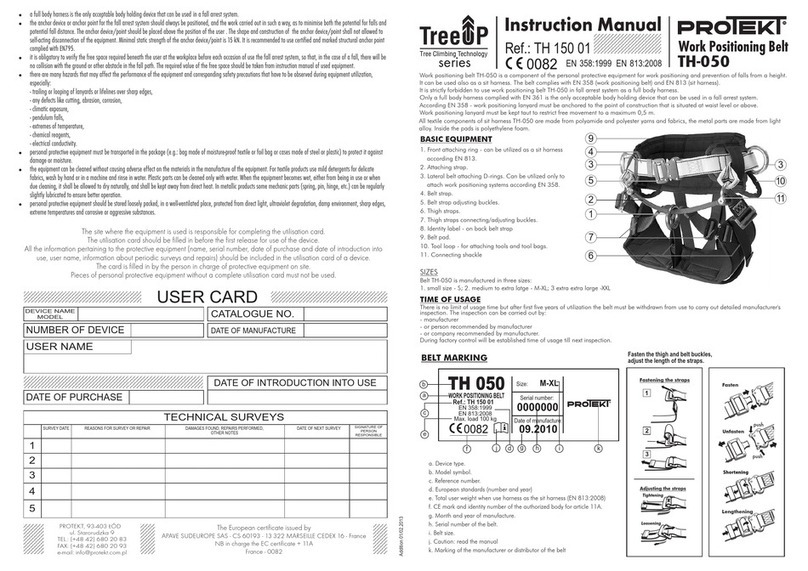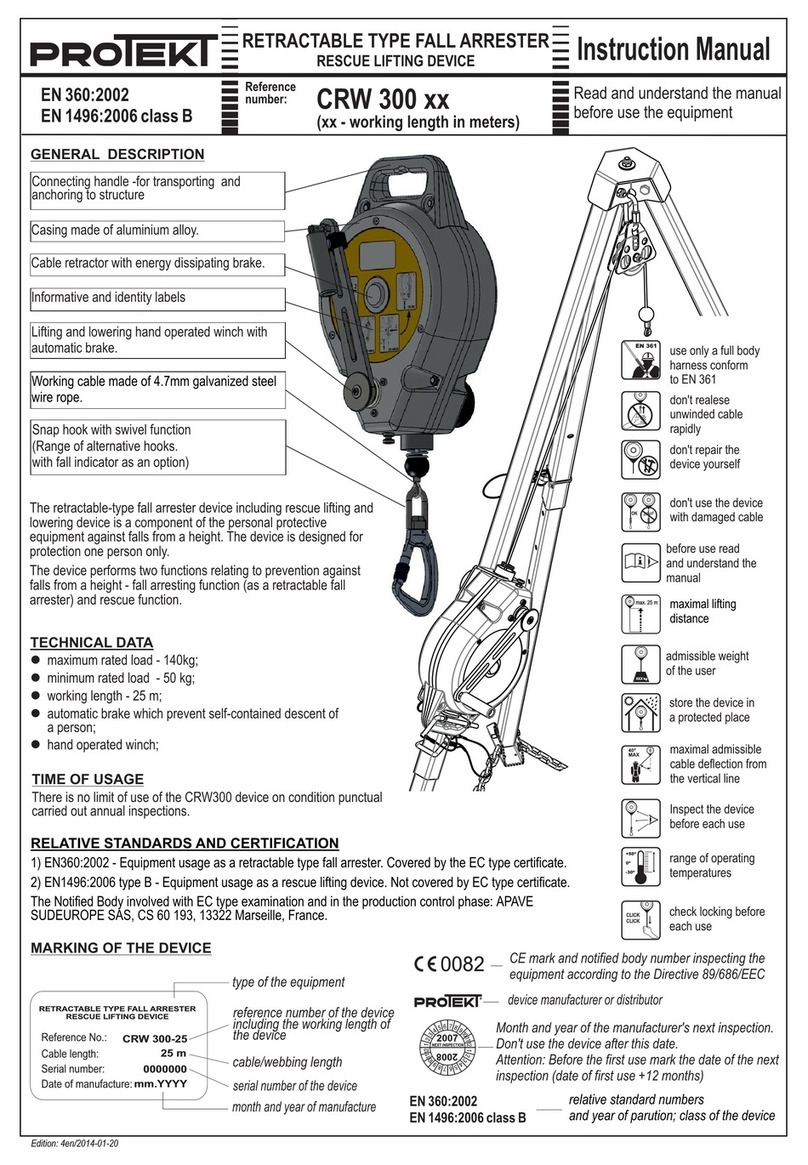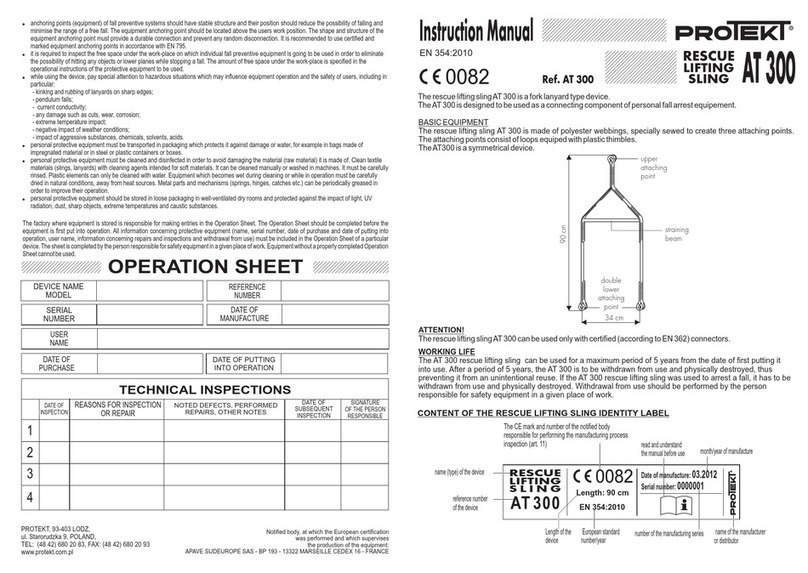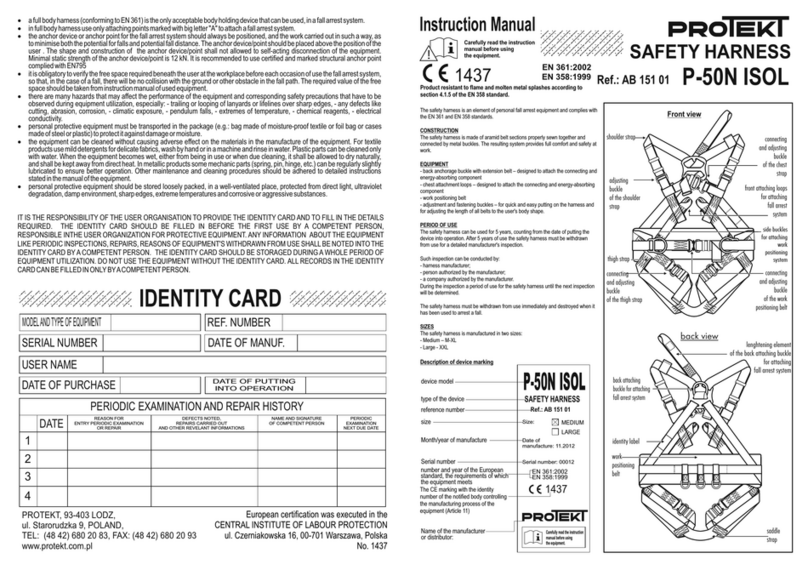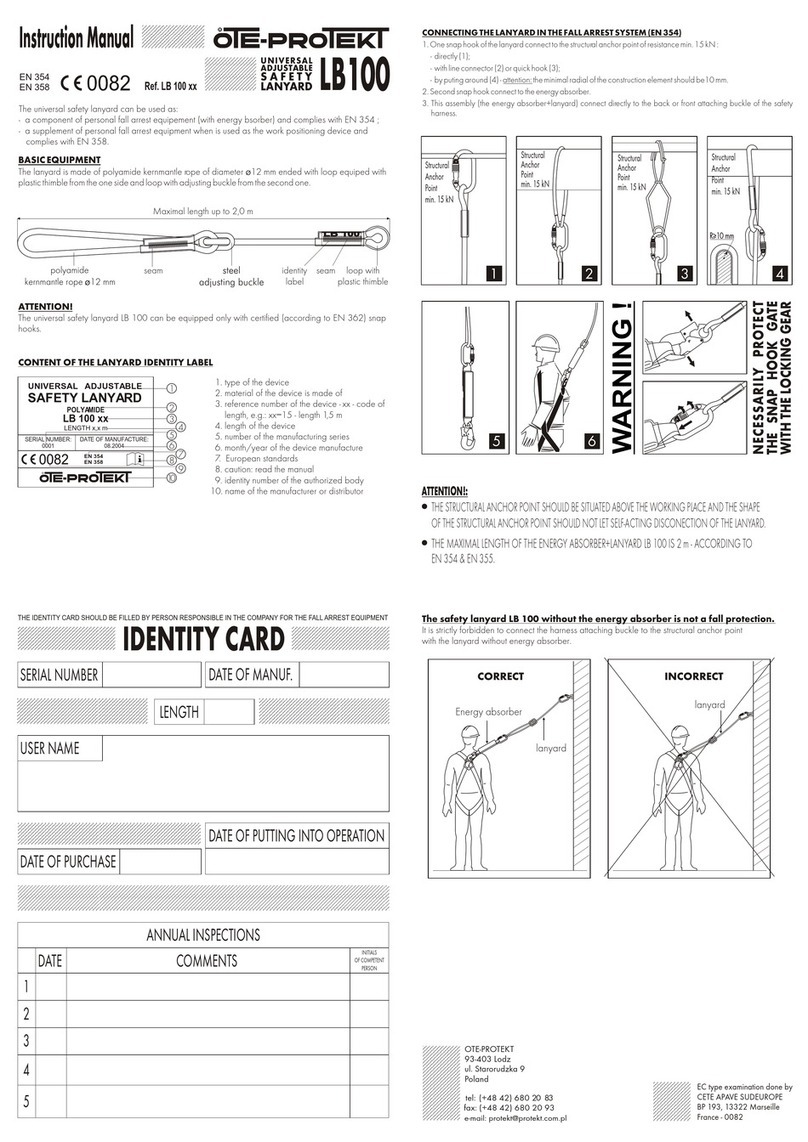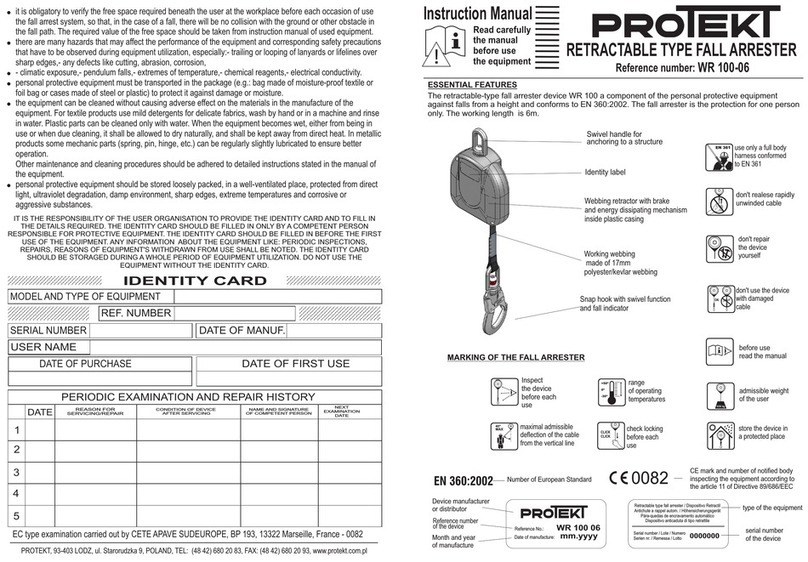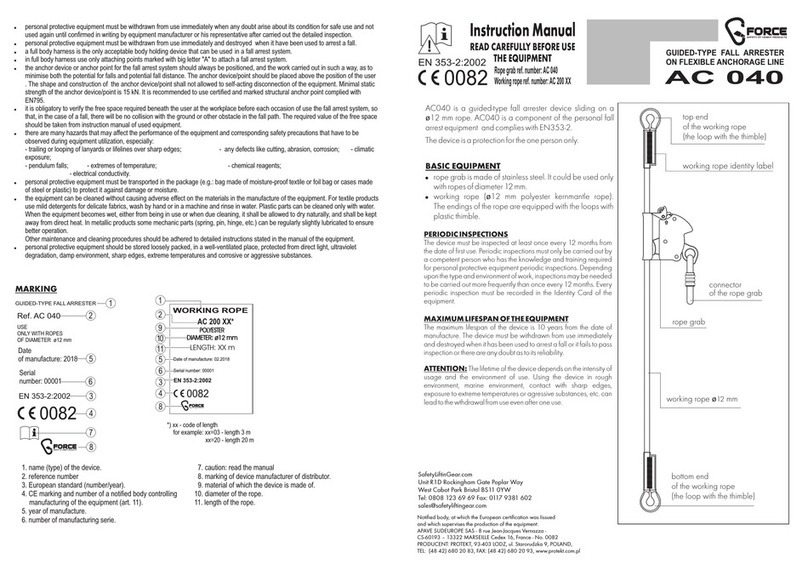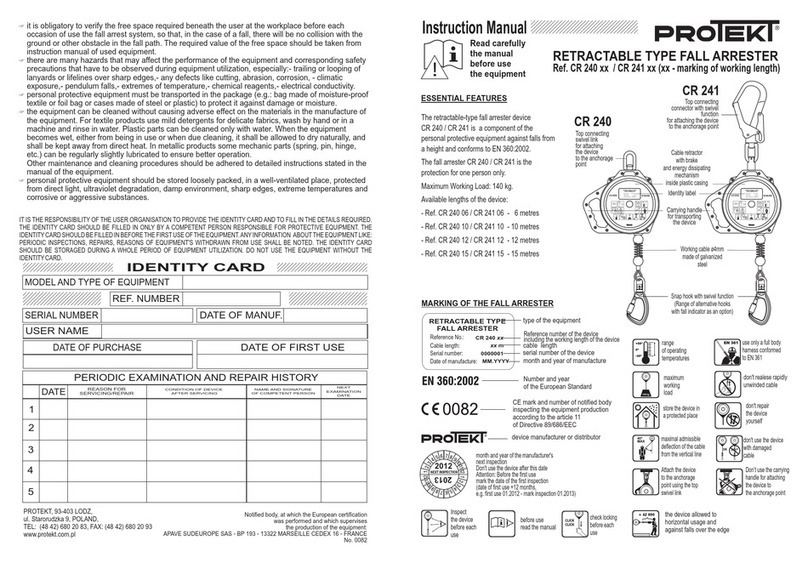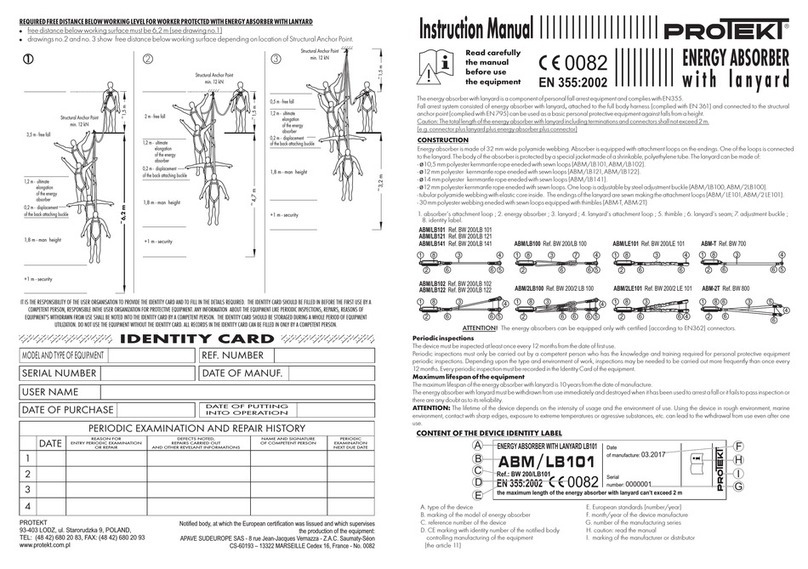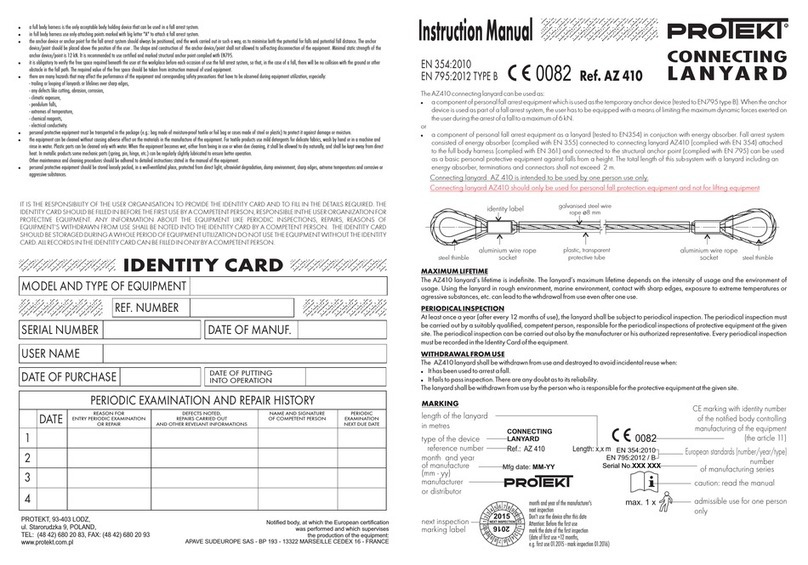
·
·
Fall arrest system must be connected only to the attaching elements of the
harness marked by capital letter A. The fall arrest system must be connected
only to: - dorsal attachment D-ring - drawing (1) or - to frontal attachment D-
ring. The dorsal attachment D-ring is marked by a capital letter A -placed on the
label sewn on above the D-ring. Front attachment D-ring is marked by a capital
letter A placed on the label sewn on near the D-ring . See drawings.
·work positioning or restraint system can be attached only to the lateral buckles of
the work positioning belt or to the frontal waist buckle or to the rear waist buckle -
work positioning lanyard must be anchored to the point of construction that is
situated at waist level or above.
·work positioning lanyard must be kept taut to restrict free movement to a
maximum 0,6 m.
PUTTING ON THE HARNESS
Fastening the straps
Adjusting the straps
Tightening
Loosening
ATTENTION:
Always protect free end of the strap with the loop
Harness is put on correctly if:
all straps are correctly adjusted (neither too loose nor too tight).
back attaching buckle is correctlypositioned at the level of the shoulder blades.
front connecting snap hook is correctlypositioned at the middle of the chest.
the ends of the all straps must be kept by plastic loops.
·personal protective equipment shall only be used by a person trained and competent in its safe use.
·personal protective equipment must not be used by a person with medical condition that could affect the safety of the equipment user
in normal and emergency use.
·a rescue plan shall be in place to deal with any emergencies that could arise during the work.
·being suspended in PPE (e.g. arresting a fall), beware of suspension trauma symptoms.
·to avoid symptoms of suspention trauma, be sure that the proper rescue plan is ready for use. It is recommended to use foot straps.
·it is forbidden to make any alterations or additions to the equipment without the manufacturer's prior written consent.
·any repair shall only be carried out by equipment manufacturer or his certified representative.
·personal protective equipment shall not be used outside its limitations, or for any purpose other than that for which it is intended.
·personal protective equipment should be a personal issue item.
·before use ensure about the compatibility of items of equipment assembled into a fall arrest system. Periodically check connecting
and adjusting of the equipment components to avoid accidental loosening or disconnecting of the components.
·it is forbidden to use combinations of items of equipment in which the safe function of any one item is affected by or interferes with the
safe function of another.
·before each use of personal protective equipment it is obligatory to carry out a pre-use check of the equipment, to ensure that it is in a
serviceable condition and operates correctly before it is used.
·during pre-use check it is necessary to inspect all elements of the equipment in respect of any damages, excessive wear, corrosion,
abrasion, cutting or incorrect acting, especially take into consideration:
- in full body harnesses and belts - buckles, adjusting elements, attaching points, webbings, seams, loops;
- in energy absorbers - attaching loops, webbing, seams, casing, connectors;
- in textile lanyards or lifelines or guidelines - rope, loops, thimbles, connectors, adjusting element, splices;
- in steel lanyards or lifelines or guidelines - cable, wires, clips, ferrules, loops, thimbles, connectors, adjusting elements;
- in retractable fall arresters - cable or webbing, retractor and brake proper acting, casing, energy absorber, connector;
- in guided type fall arresters - body of the fall arrester, sliding function, locking gear acting, rivets and screws, connector, energy
absorber;
- in connectors - main body, rivets, gate, locking gear acting.
·after every12 months of utilization, personal protective equipment must be withdrawn from use to carry out periodical detailed
inspection. The periodic inspection must be carried out by a competent person for periodic inspection. The periodic inspection can be
carried out also by the manufacturer or his authorized representative.
·In case of some types of the complex equipment e.g. some types of retractable fall arresters the annual inspection can be carried out
only by the manufacturer or his authorized representative.
·regular periodic inspections are the essential for equipment maintenance and the safety of the users which depends upon the
continued efficiency and durability of the equipment.
·during periodic inspection it is necessary to check the legibility of the equipment marking.
·it is essential for the safety of the user that if the product is re-sold outside the original country of destination the reseller shall provide
instructions for use, for maintenance, for periodic examination and for repair in language of the country in which the product is to be
used.
·personal protective equipment must be withdrawn from use immediately when any doubt arise about its condition for safe use and
not used again until confirmed in writing by equipment manufacturer or his representative after carried out the detailed inspection.
·personal protective equipment must be withdrawn from use immediately and destroyed (or another procedures shall be introduced
according detailed instruction from equipment manual) when it have been used to arrest a fall.
THE ESSENTIAL PRINCIPLES FOR USERS OF PERSONAL PROTECTIVE EQUIPMENT AGAINST FALLS FROM A HEIGHT
WARNING:
1) It is strictly forbidden to attach any fall arrest system to lateralor rear buckle of work positioning belt.
2) It is strictly forbidden to attach any fall arrest system to frontal buckle designed for use as a sit harness according EN 813.
ATTACHING FALL ARREST SYSTEM
ADMISSIBLE TIME OF USE
Safety harness can be used for 5 years. After this period the harness manufacturer's
The manufacturer's inspection can be carried out by:
- manufacturer
- or person recommended by manufacturer
- or company recommended by manufacturer.
During this inspection will be established admissible time of harness use till next manufacturer's inspection.
must be withdrawn from use to carry out detailed
inspection
ATTENTION: Before use the belt the first
time the user should carry out a suspension
test in a safe place to ensure that the sit
harness is the correct size, has sufficient
adjustment and is of an acceptable comfort
level for the intended use.
A B C D E
A. Take the harness by the
shoulder straps. Disconnect
shoulder straps from
connecting hook [Y].
B. Move the straps over the
head. Taking the harness
by the belt, put them on
over the feet.
C. Connect shoulder
straps
to connecting hook
[Y].
D. Adjust the belt strap.
Necessarily protect free
ends of the straps with
the loops.
Adjust the shoulder
E. Fasten and adjust the
thigh straps.
Necessarily protect
free ends of the straps
with the loops.
Y
Y
1
2
3
2
1
